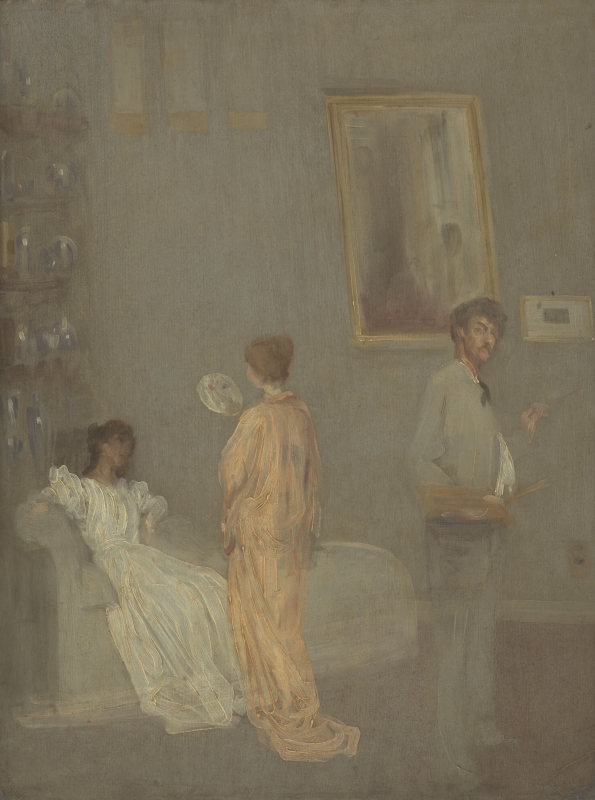The Artist in his Studio (Whistler in his Studio) was probably started in London in August 1865, continued in the early 1870s, and touched up in 1895.
1865: Both The Artist in his Studio (Whistler in his Studio) and The Artist's Studio [YMSM 062] relate to a large picture Whistler intended to submit to the Salon in 1866. He described the proposed figure composition to Ignace-Henri-Jean-Théodore Fantin-Latour (1836-1904) on 16 August 1865:
'J'ai pour le salon une réunion de nous autres à mon tour - j'en ai fait une esquisse qui est bigrement bien - ca représente l'intérieur de mon atelier - porcelaine et tout! Il y a toi et Moore, la fille blanche assise sur un canapé et la Japonaise qui se promène! enfin un apothéose de tout ce qui peut scandaliser les Académiciens, les couleurs choisies sont charmantes. moi en gris clair - la robe blanche de Jo - la robe couleur de chair de la Japonaise (vue de dos) toi et Moore en noir - le fond de l'atelier gris - c'est en hauteur, et aura à peu près dix pieds de haut, sur six ou sept de large.' 1Translation: 'In my turn I have a reunion of all of us for the Salon - I have done a sketch of it which is really good - it shows the interior of my studio - porcelain and all. You are there, and Moore, the white girl sitting on the couch, and the Japanese girl walking about! An apotheosis therefore of everything to outrage the Academicians, the colours I have chosen are charming - Me in light grey - Jo's white dress - the flesh-coloured dress of the Japanese girl (seen from behind) you and Moore in black - the studio background grey - It's upright, and will be about ten feet high, and six or seven wide.'
Both The Artist in his Studio (Whistler in his Studio) and The Artist's Studio differ from this description, in that neither Albert Joseph Moore (1841-1893) nor Fantin-Latour are now visible. The phrase 'à mon tour' refers to Fantin-Latour's group portraits, Hommage à Delacroix (Salon 1864; Musée d'Orsay, Paris) and Hommage à la Verité: Le Toast, in both of which Whistler's portrait appeared. Le Toast was shown at the Salon in 1865, then cut into fragments by the artist. Some of the portrait heads survive, the self-portrait and the portrait of Whistler being in the Freer Gallery of Art. There is, however, no record of Whistler going on to paint the large picture mentioned in his letter to Fantin-Latour.
1868: Mary Glenn Perine (1822-1896) visited Whistler's mother at 2 Lindsey Row and described seeing a model, the wife of an 'Ethiopian minstrel', posing for Whistler in Chinese drapery. 2 The model was Emelie 'Millie' Eyre Jones (1850-1920), who was married to an actor or 'black and white minstrel'. She may have been posing for The Artist in his Studio (Whistler in his Studio).
1871/1874: Whistler may have continued to work on Whistler in his Studio for several years. The butterfly signature was added in the early 1870s, which implies either that he was still working on it, or that he signed it for exhibition, sale, or in order to sell or give it to his brother, William McNeill Whistler (1836-1900) .
1895: Over thirty years later, Whistler was asked to complete one of the heads, and, as he told his brother, 'touched up the little head in the studio picture' in Paris in July 1895. 3
Last updated: 4th December 2020 by Margaret






